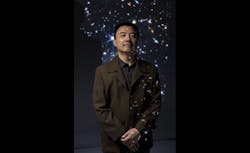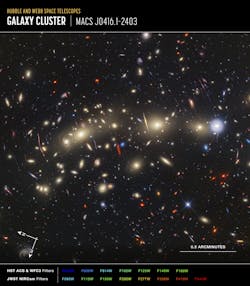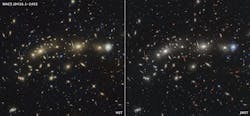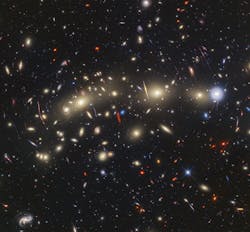Webb’s infrared images reveal transients within Christmas Tree Galaxy Cluster
An international team of scientists led by University of Missouri’s Haojing Yan, an associate professor of physics and astronomy, recently used NASA’s Webb Space Telescope to discover 14 transient objects during a time-lapse study of galaxy cluster MACS0416 (see Fig. 1)—located about 4.3 billion light years from Earth—and named it the Christmas Tree Galaxy Cluster because of its twinkling light show.
Transients are objects in space, like individual stars, which appear to suddenly brighten by orders of magnitudes and then fade away. The team discovered the transients by studying four sets of images taken by Webb of the galaxy cluster during a period of 126 days.
“During the past few decades, the study of transients or what we call the ‘time domain science,’ has been recognized by the astronomical community as an important new field that will reveal new physics of the universe,” says Yan. “I’m one of the astronomers who sees the important role Webb can play in this new era.”
Transient objects are difficult to study because they appear brighter for only a short period of time and then vanish. “It’s like we’re peering through a shifting magnifying glass,” says Yan. “Right now, we have this rare chance nature has given us to get a detailed view of individual stars located very far away. While we’re currently only able to see the brightest ones, if we do this long enough and frequently enough, we’ll be able to determine how many bright stars there are and how massive they are.”
Webb’s advanced capabilities helped Yan and his team confirm what’s causing the galaxy cluster’s twinkling lights or transients that scientists first saw years ago using Hubble. They were thrilled to discover that two of the transients are supernovae—stars at the end of their lifespans—that can be used to explore the supernovae’s host galaxies.
Gravitational lensing
Two types of gravitational lensing effects are involved in the team’s work. When light from distant sources travels through warped space, it appears as if the light is bending around the massive object. Akin to light being redirected through a glass lens, gravitational lensing changes the way background sources appear—as magnified and distorted images.
“One is the strong lensing effect due to the galaxy cluster as a whole,” says Yan. “Some of the background galaxies are extremely amplified because of their alignment with the cluster and us. There are also stars within the cluster not bound with any particular member galaxies of the cluster that, due to their motions within the cluster, can be aligned with those already aligned background galaxies for a short period of time.”
This can give rise to another lensing effect: microlensing. “The combination of the two lensing effects enabled us to detect 12 (out of 14 total) transients, which are individual stars in the far-away background galaxies. Our current technology—and any foreseeable ones—wouldn’t be able to detect individual stars in galaxies so far away without such lensing effects,” says Yan.
While lensing effects have been exploited by the Hubble, Webb’s unprecedented sensitivity and spatial resolution enables the team to take this study to a new level.
“Hubble scratched the surface,” says Yan. “Our study is beginning to see the ‘tip of the iceberg.’ Future observations with Webb, if properly designed, will allow us to go to yet another new level and create new constraints that will help us understand dark matter.”
With previous studies using Hubble, it was envisioned that Webb could find many transients. “But when we indeed found so many, it was still jaw-dropping,” says Yan. “Beyond this type of transients that were previously envisioned, the discovery of two supernovae—stars that increase their brightness by more than a billion times as they die and explode—was unexpected.”
Hubble wouldn’t have seen them, but Webb saw them with ease, thanks to its unprecedented sensitivity and resolution in infrared light (see Fig. 2). “Repeated Webb observations in different areas have found supernovae in a similar way,” says Yan. “This is a new avenue that we can and should further exploit. As for how I felt, while it sounds cliché, my feeling was: a new window just opened.”
The team’s biggest challenge now is “very careful analysis to ensure the transients are real and not some artifacts,” Yan adds.
Webb and Hubble join forces to produce panchromatic image
NASA’s Webb and Hubble space telescopes are also working in tandem to study the Christmas Tree Galaxy Cluster, which is actually a pair of colliding galaxy clusters that will eventually combine to form an even more gigantic cluster. A panchromatic image (see Fig. 3) from the two space telescopes combines visible and infrared light to assemble one of the most comprehensive views of the universe ever taken.
The panchromatic image reveals a bounty of galaxies outside the cluster and a handful of sources that vary over time, likely due to gravitational lensing, a.k.a. the distortion and amplification of light from distant background sources.
This cluster was the first of a set of unprecedented, super-deep views of the universe. Hubble pioneered the search for some of the faintest and youngest galaxies ever detected, but Webb’s infrared vision significantly enhances it by reaching even farther into the early universe.
How was the NASA image made? In general, the shortest wavelengths of light are color-coded blue, the longest wavelengths red, and intermediate wavelengths green. The broad range of wavelengths—from 0.4 to 5 µm—yields a particularly vivid landscape of galaxies.
These colors/wavelengths drop clues to galaxy distances. The bluest galaxies are relatively nearby and often show intense star formation, which is best detected by Hubble, while the redder galaxies tend to be more distant and best detected by Webb. Some galaxies also appear super red, according to NASA, because they contain copious amounts of cosmic dust that tends to absorb bluer colors of starlight.
Quest for dark matter
Studying individual stars amplified by gravitational lensing can help us learn how the stellar constituents of far-away galaxies are different from—or the same as—our own galaxy. “It can also help us study the dark matter content of the lensing cluster (MACS0416) in a detailed way that wasn’t achievable before,” says Yan. “Studying supernovae at further and further distant universe will help us test our cosmological model and understand the nature of dark energy.”
The team’s study is indeed just the tip of the iceberg. “With programs of a similar nature but at larger scales, we will be able to bring it to yet another new level,” says Yan. “We’ve proposed to do this, but it’s up to the telescope time allocation committee to decide.”
FURTHER READING
H. Yan et al., arXiv:2307.07579v2 [astro-ph.GA] (Oct. 11, 2023); https://doi.org/10.48550/arXiv.2307.07579.
About the Author
Sally Cole Johnson
Editor in Chief
Sally Cole Johnson, Laser Focus World’s editor in chief, is a science and technology journalist who specializes in physics and semiconductors.




